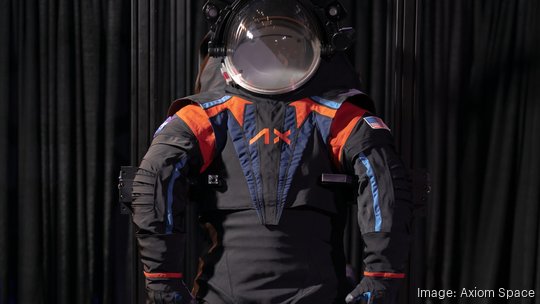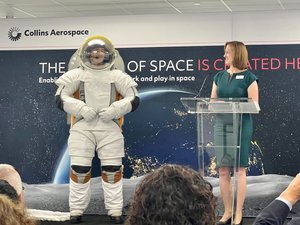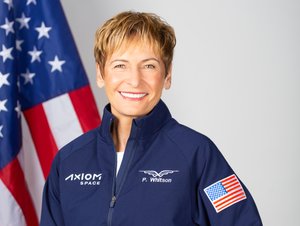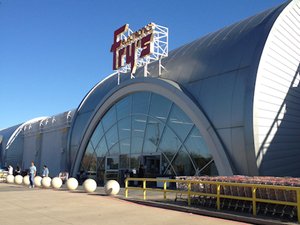
NASA and Houston space tech company Axiom Space are preparing for mankind’s next giant leap with a newly revealed spacesuit designed for walking on the moon.
The Axiom Extravehicular Mobility Unit, or AxEMU, suit was revealed on March 15 during Space Center Houston’s Moon 2 Mars Festival, a weeklong event celebrating local space innovation. The suit was presented by NASA and Axiom personnel, including Johnson Space Center Director Vanessa Wyche, Axiom Space CEO Michael Suffredini and Axiom Mission 2 flight commander Peggy Whitson.
“Axiom Space’s Artemis III spacesuit will be ready to meet the complex challenges of the lunar south pole and help grow our understanding of the moon in order to enable a long-term presence there,” Suffredini said in a statement.
The project is the result of Axiom’s $228.5 million contract, which NASA awarded in September. The suits will be used in NASA’s upcoming Artemis III mission, the first return to the moon in over 50 years.
Wyche emphasized the new suit represents a step forward in spacesuit technology. According to Wyche, NASA’s current design dates to the age of space shuttles.
“So, (for) 40 years, we've been using the same suit based on that technology,” Wyche said. “And now today, Axiom is going to innovate.”
The Artemis mission will explore the southern part of the moon, where frozen water has been recorded on past missions. The extreme conditions of the moon’s surface influenced some of the suit’s design, according to Russell Ralston, Axiom Space’s extravehicular activity, or EVA, deputy program manager.
Suffredini said the suit’s design was half based off previous designs from NASA for an extravehicular mobility suit, or EMU, with Axiom adding its own contributions to the other half. One of the suit’s features is a hard upper torso based off NASA prototype designs.
Ralston and Lara Kearney, NASA’s human surface mobility program manager, emphasized the suit’s use of different joint types to allow astronauts to conduct repairs and manipulate tools in space. Other features include a rear-entry design, meaning that astronauts will enter the suit from a hatch in the back, unlike current suit designs.
During a media briefing, Ralston told the Houston Business Journal that bridging the gap between current spacesuit technology and NASA’s requirements for the Artemis mission relied heavily on private development.
“In terms for Axiom and how we kind of approach suit design, we look at all of that work that's been done, the technology development for each component,” Ralston said. “The requirements we’re working with are slightly different from [NASA’s] xEMU [suit], so we expect to see some changes.”
The terms of the service contract mean that Axiom retains ownership of the hardware and can sell the suit to other commercial customers, according to Kearney. Mark Greeley, Axiom’s EVA program manager, said the suit could also be compatible for Axiom’s own commercial space station project.
In addition to its work on the Artemis mission, Axiom has its own designs on spaceflight. Earlier in 2023, the company confirmed the four-person crew for Axiom Mission 2. In addition to Whitson and former aviator John Shoffner, Ali AlQarni and Rayyanah Barnawi of the Kingdom of Saudi Arabia will serve as mission specialists and will represent the country’s growing space program.
On March 14, NASA also announced that Axiom Mission 3 will launch no earlier than November 2023 and is expected to spend 14 days docked to the space station, NASA said.
In 2021, Axiom and SpaceX signed a partnership for four commercial missions, starting with last year's Axiom Mission 1.
Meanwhile, Axiom is expanding its Houston presence with its new headquarters at the Houston Spaceport. The 22-acre Space Flight and Assembly Headquarters will be used to train private astronauts and to produce the Axiom Station, which has been billed as the world’s first free-flying, internationally available, private space station. The headquarters broke ground in 2022 and is expected to be complete this year.
While the Spaceport project was underway, Axiom also leased a 146,000-square-foot former Fry’s Electronics building in Webster in June 2022.










